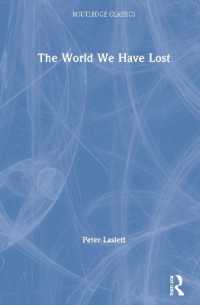- ホーム
- > 洋書
- > 英文書
- > Science / Mathematics
Full Description
This book for the first time covers state-of-the-art research in two domains which are largely complementary, but which have until now not made optimum use of their complementarity: remote sensing techniques and climate models. The material presented in the book covers such diverse areas within satellite remote sensing techniques as aerosol loading of the atmosphere, characterization of the land surface (type and extent of vegetation, reflectivity of snow, land and vegetation), soil moisture, etc. Such parameters are important determinants of the climate system and its evolution, and are often poorly quantified in climate models; the advantage of remote sensing techniques, which have a global coverage, therefore becomes obvious for the climate modeling community. The book is primarily aimed at advanced academic research, at PhD or post-doctoral levels and beyond.







